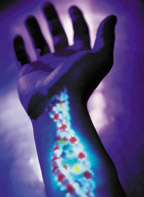Biometrics, which replace a card with a unique characteristic of a person's body (such as hand, fingerprint, voice or face), have made the most inroads in U.S. applications. Biometric readers today are protecting everything from server rooms to computer access to daycare facilities.

Why Consider Biometrics?
It is a strong indication of the main line nature of today's biometrics that resellers and systems integrators of numerous sizes are eagerly handling products based on the personal identifier technology. Take for example Henry Olivares of A-Professional Locks, Inc., Gilbert, Ariz. He says his company has been selling biometrics for two years. "Most of it has been at the customer's request," he says. "They didn't want to carry any credentials or codes and wanted to ensure the person gaining access was that person. That's where biometrics typically come into play. We sell fingerprint and hand geometry readers. I know as time moves on others, such as retina, face and voice, will gain popularity."Olivares observes, "Years ago it was all magnetic stripe or bar code. Now it's all proximity. In a few years we see biometrics replacing proximity."
In some instances, that evolution already has started to happen. "We've seen people use this for single door systems," says Bill Spence of Identix, Los Gatos, Calif. Identix fingerprint readers aim at the physical and logical access control markets. One of the firm's offerings, the V20, integrates into existing proximity card systems so end users can apply it in either standalone or network configurations. Such emerging biometrics device capabilities allows end users to leverage the increased convenience and security of biometrics into more and more access control solutions, even those for smaller and mid-sized systems.
Robert Sawyer of Group 4 Securitas Technology Corp., Torrance, Calif., believes that biometrics are definitely being end user driven. "The customer sees the availability of biometrics in different trade magazines, the general press and television...[so] it is becoming more widely accepted."
Interfaces also drive more use of biometrics. For example, a special interface to the hand reader from Recognition Systems, Inc. (Ingersoll-Rand, Campbell, Calif.) makes it easier to retrofit to access control panels. Adds Sawyer, "The size of the template required fits in with panel technology very easily. We've networked with probably most of the biometric technologies available."
While Sawyer notes that interest is increasing. "It's primarily security-driven right now on the customer end. The end user is looking for a higher degree of security than provided with a normal proximity card."
The technological approaches to biometrics vary but there also are common elements for all of them.
Concerning a person's eyes, there are retinal and iris based systems. Concerning a person's hands and fingers, there are systems that measure and compare a person's finger or hand, but, especially in the law enforcement arena, there are systems that measure and compare a full set of fingers. Most finger biometrics depend on one finger, however.
There are voice-based systems as well as systems that use the ways a person types a password or phrase on a keyboard.
There are facial recognition systems that measure a number of biometric items within a person's face.
Depending on the type of biometric approach, readers also vary - with finger biometrics boasting the smallest reader being applied to laptop computers, for example, as compared to special data collection devices for iris and retinal scanning and hand geometry, for example.
The Biometrics Sell
Of course, for some end users appreciate more education and explanation than with traditional card-based systems. Adds Mike Dismore of Ener-Tel, San Angelo, Texas, "[Corporate end users] don't realize that it's available and affordable for them, and that they can put it on their buildings now."The cost differential between biometrics and more traditional access control technologies has long been a concern. But one that is diminishing with time.
Spence says, "The cost differential between cards and biometrics isn't that great."
"The challenge...is that many end users managed a card system before, so they need to be educated about the potential recurring costs."
Many times with biometrics, you don't have to have people administering card functions full time . You don't have to buy any cards. That's certainly a savings. Those savings are recurring costs and customers should weigh that against the additional cost of the readers when they look at systems.
In addition, when viewing the cost equation, the size of the installation is not the important issue when it comes to biometrics. A SECURITY survey of end users as part of its annual Industry Forecast research showed that there are a growing number of buildings with proximity that also includes several doors with biometrics.
Dismore adds that the cost of biometrics can also be offset in applications where several departments are using the readers. "We can go into a hospital setting and do door security with security on computers, as well as time clock and get three departments to share the cost of the system. There we certainly have a competitive edge. No one else can bring so many budget centers together on a single system."
Installing Biometrics
Installing biometrics is not much different from installing a card reader. Many biometrics readers, for example, use a standard Wiegand interface and can easily integrate into existing proximity card systems. Many units offer internal user memory, with room for hundreds of users, and can be optionally expanded as well as networked with distributed database capability.Still, there are some differences that add to end user benefits. Even though you are interfacing with the reader like you would with any system, you still have to network within the readers so there is one source of enrollment. Even here, an end user can easily phase in biometrics into an existing system, one reader at a time.
